Play Critically was provided with a review code for this videogame.
UnderMine is a procedurally generated dungeon crawler with real-time combat and meta progression systems about a gold mine that hides much more than gold. I play as one of an endless string of hapless peasants who are dropped down a mine shaft. There they meet Arkanos, an archmage who recruits them to investigate tremors that are threatening to collapse the mine. They delve into the mine, soon discovering that a massive sandworm named Selt is responsible for the tremors. The day seems saved when Selt is defeated, but she proves only the first of the mine’s dangerous secrets. It falls to me and a neverending procession of peasants to fulfill all of Arkanos’ enigmatic requests, uncover the mine’s mysteries, and—what else—save the world from a power-hungry villain.
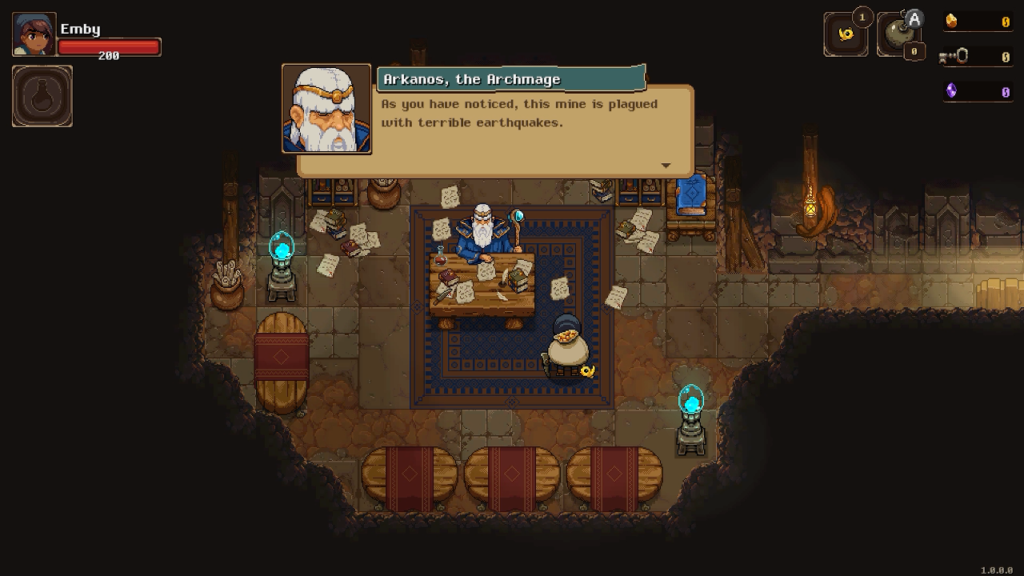
My goal is to guide my conscripted peasant player character down through the mine’s twenty increasingly unusual floors. Along the way I defeat bosses who drop key fragments that unlock the final encounter. Each peasant enters the mine with the same equipment: A sack, a familiar, and a pickaxe. The sack holds the peasant’s accumulated treasures. The familiar supports the peasant by gathering items or fighting enemies. The pickaxe serves double-duty as a tool to pry gold chunks loose from the wall and also a weapon to wield against the mine’s hostile denizens.
I can attack by swinging the peasant’s pickaxe in melee range or throwing it like a boomerang. Each method has different levels of risk. Melee attacks deal more damage and swing faster but leave the peasant vulnerable to counterattacks. Thrown attacks deal less damage and take longer before I can throw again but keep the peasant safe from counterattacks.
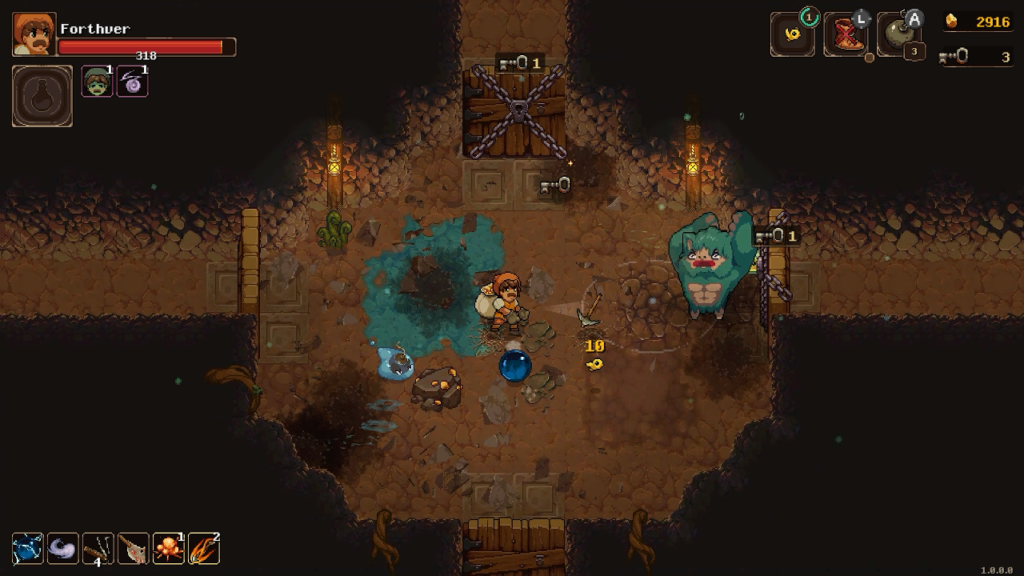
Different enemies require different strategies. Some have few hit points and attack from a range, begging to be boomeranged with the pickaxe. More complicated are melee enemies; some are more vulnerable before they attack, others after they attack, and it takes practice and experience to learn which is which. I can only know for certain that charging at enemies recklessly swinging the pickaxe will lead my peasant to a certain death.
Where UnderMine really stands out, particularly due to its top-down perspective, is in the peasant’s jumping prowess. It is useful for navigation, letting me leap over some pits to cut corners across a room. It is also handy for evading enemy projectiles and attacks. The most devious challenges require me to jump over traps while fighting enemies at the same time.
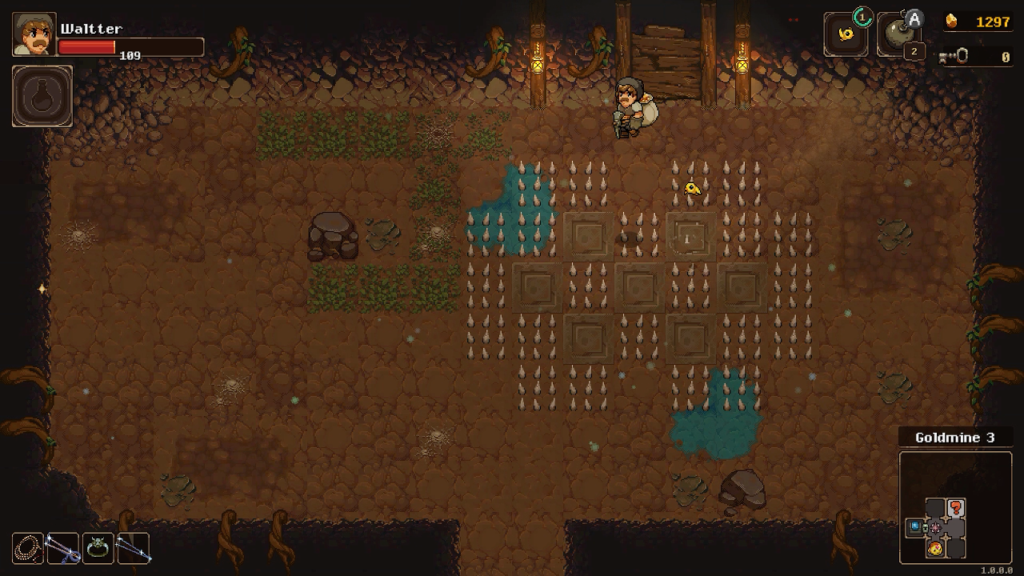
Jumping is functional as a blunt-force tool but lacks precision. When items appear surrounded by spikes I must jump over, I always end up landing on the spikes instead of the item. Platforming is not UnderMine’s strength, but it occurs rarely enough that I never feel a run is ruined by my blunders.
The peasant’s abilities can be modified by picking up relics strewn throughout the mine. Some have straightforward modifications, like the Battle Axe which increases the pickaxe’s melee range but decreases its damage. Others confer elemental powers to attacks which have further effects on the environment. When the pickaxe is charged by Bottled Lightning it can electrocute pools of water, damaging anything that steps in them. When it is imbued with fire from a Salamander’s Tail it can ignite oil with damaging flames. Fire also cooks food, increasing its healing powers.
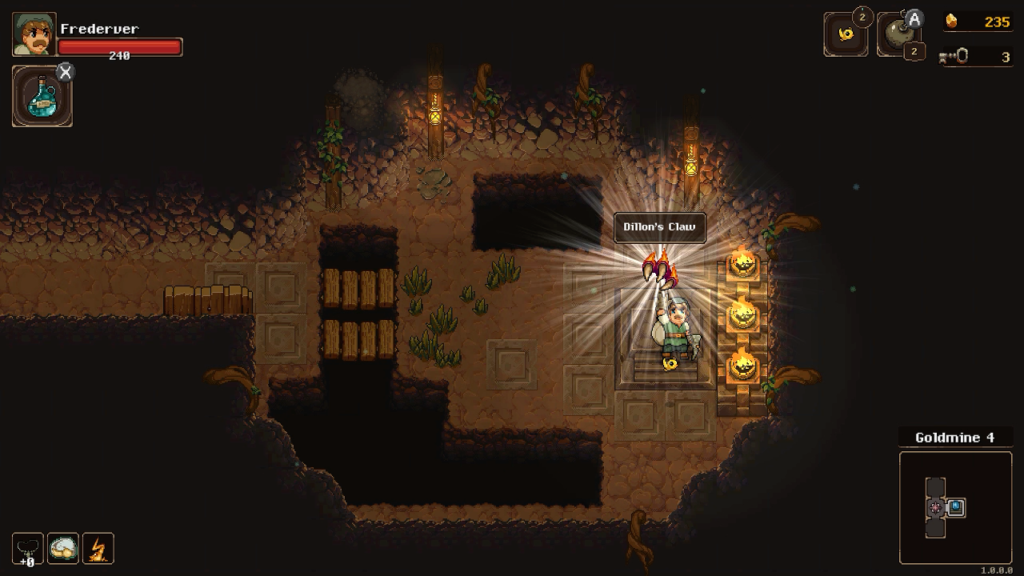
By exploring every room in a floor, using recovered keys to open locked doors and bombs to break open boulders and walls, I can discover the shaft that leads to the next floor. Each shaft I drop down brings me one floor closer to the next boss.
When my current peasant is killed then their familiar will carry their sack back to the mine entrance, passing its contents on to their successor. This inheritance is key to turning the entrance from a barren cave where only Arkanos lurks in his study to a bustling marketplace.
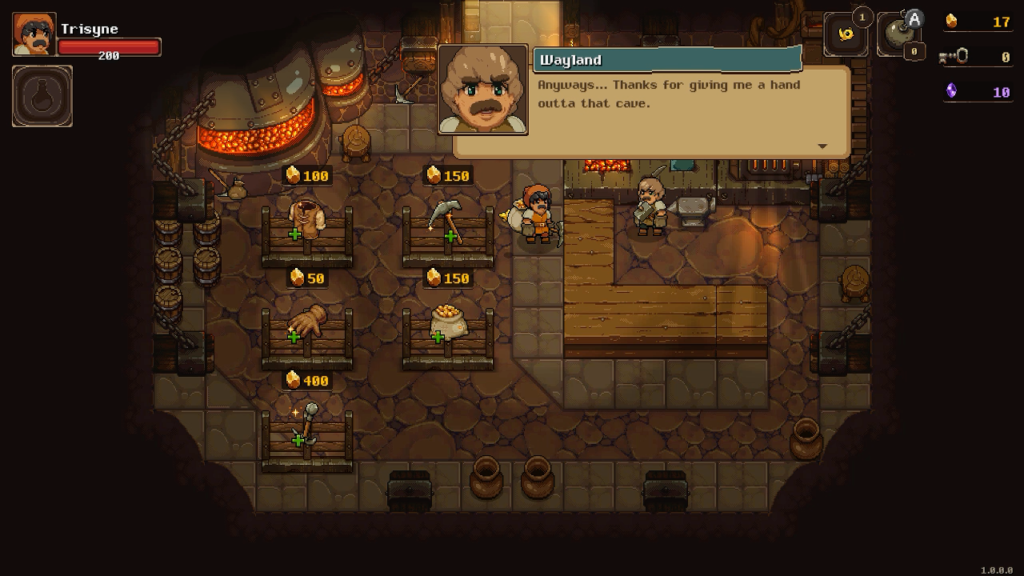
Some hub additions are easy. Wayland the Blacksmith moves there when I discover his workshop behind a caved-in doorway with my first peasant. Dodson the Bombsmith joins when I free him from his cell deeper in the mine. Others are more complicated. To open Baba’s Alchemist shop, I must help her assistant Beltrame discover three mushrooms hidden in the mine. The mushrooms are carried from peasant to peasant via the sack once I discover them, softening the randomness endemic to the genre; I need to find all three in random dungeon layouts, but I don’t need to find all three in a single run. Through this compromise UnderMine honors the traditions of its genre but also respects my time and effort.
To purchase any of the upgrades offered by the hub’s merchants I need gold. Lots and lots of gold. It is found embedded in the walls of almost every room in the mine and scatters across the floor when I hit it with the pickaxe. Mischievous slimes called Pilfers appear to steal gold left lying on the floor so I must scramble to touch nuggets and add them to the peasant’s sack first. I can spend gold at the Pilfers’ Shop on each floor to buy keys, bombs, food, and relics to sustain my run, or I can save it. When my peasant inevitably dies, all that stockpiled gold can be spent on upgrades.
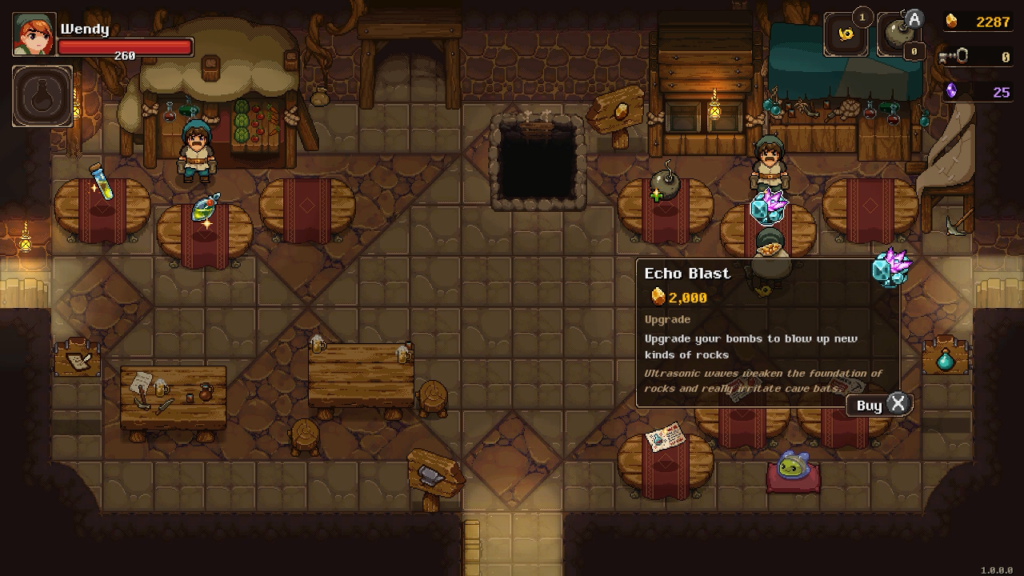
The different vendors in the hub sell a variety of items that greatly improve the peasant’s efficacy, and all future peasants benefit from any purchased upgrade. Arkanos sells seasoning that increases food’s healing power. Dodson can upgrade bombs to break new kinds of stone, which is necessary to find still more secrets in the mine. The most important merchant is Wayland, whose blacksmith upgrades greatly improve the damage potential and hit points of all my future peasants. The monsters who lurk in the mine’s first few floors are formidable opponents to a peasant with starting equipment, but after purchasing a dozen increasingly expensive pickaxe upgrades they fall in a single blow. For peasants to challenge the mine’s deepest regions, I must spend hundreds of thousands of gold on these upgrades.
If there’s a problem with this system it’s in how the difficulty spikes between each section. Equipment that is sufficient in The Gold Mine, the first region, is immediately outmatched in Delvemore Dungeons, the second region. I am essentially forced to throw my poor peasants against a solid wall until I buy enough of Wayland’s upgrades to catch up with the latest monsters . This strength-through-repetition design is a natural part of procgen dungeon crawler design, especially those following the Rogue Legacy meta progression philosophy, but it can be discouraging encountering a monster that seems at first encounter to be unstoppable.
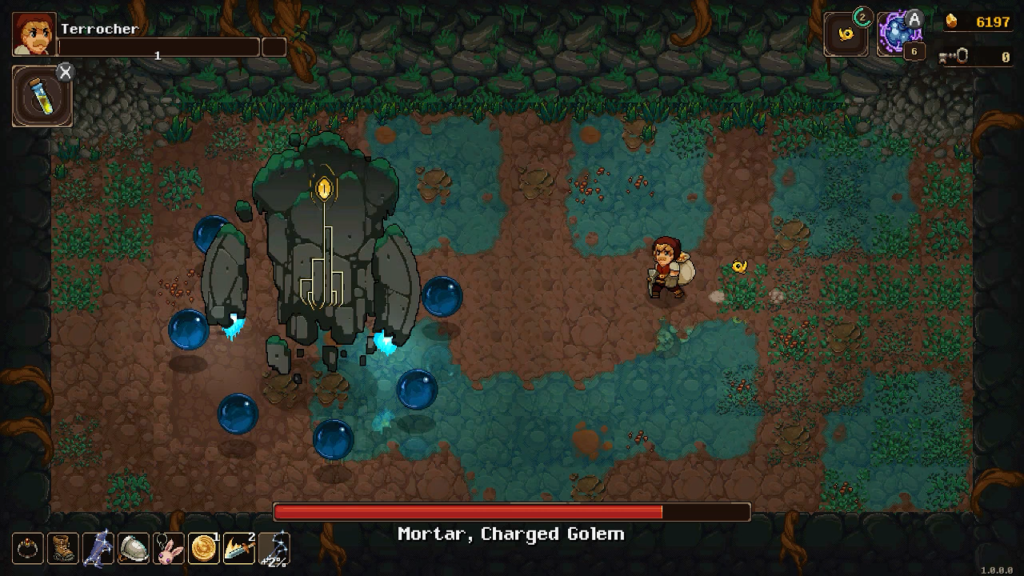
At the end of each mine region, my peasant challenges a massive boss that requires as many upgrades as I can assemble and as much skill as I can employ to defeat. A boss can be made easier with a lucky combination of relics, but they are never trivial. They expand the attack-and-retreat combat that typifies UnderMine’s standard enemies to gigantic beasts that fill the screen.
Selt the Sand Queen hatches tiny versions of herself who try to trap my peasant with their sticky excretions while Selt herself charges around her chamber. Mortar the Charged Golem is protected by a ring of crystals that can electrify the pools of water that dominate the room while it tries to crush my peasant with its floating fists. Noori the Spectre of Darkness summons grasping hands from the shadow that try to crush my peasant while it fires orbs of dark energy. Bosses have differing attacks, but my strategy against all is the same: Avoid their attack, then squeeze in as many hits of my own as I can before jumping away to safety. Rinse, repeat. It’s familiar, even predictable, but satisfying boss design.
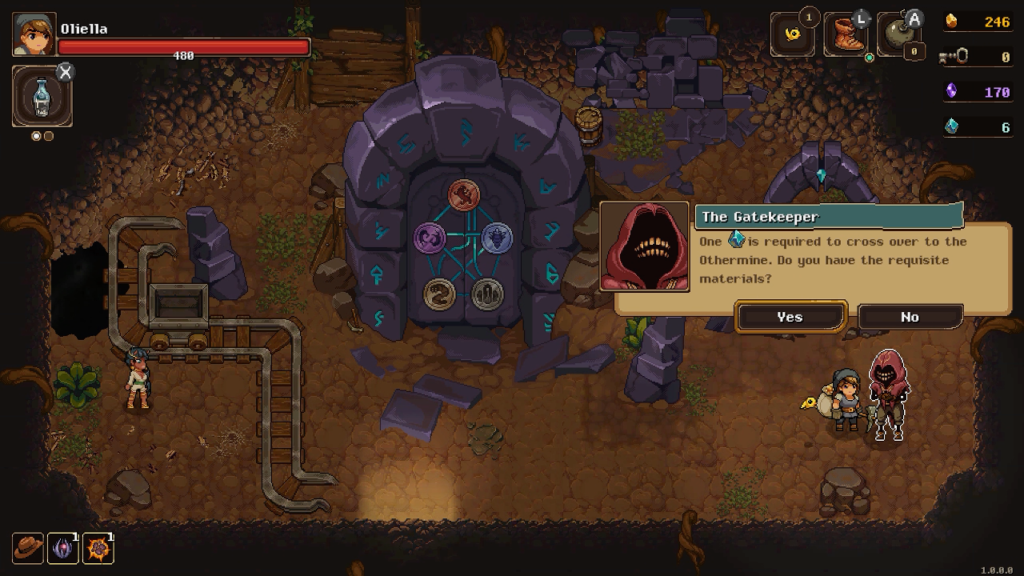
Eventually I will discover all the mine’s secrets and foil the plans of its secret villain, but in typical procgen dungeon crawler fashion there is much more to do even after the story has concluded. When the mine’s final boss falls, I can activate a stone that will resurrect all the bosses with added power. I can do this as many times as I’m able to keep killing them all; there’s even an achievement for doing it at least thirty times. There is also an alternate mine called the Othermine where my peasant is afflicted by debilitating curses. I can earn powerful new relics by overcoming these challenges. There are dozens of other relics to purchase from the hub’s vendors which requires a rare currency called thorium. There’s plenty to keep me busy after I’ve seen the credits roll if I go for one hundred percent completion.
UnderMine doesn’t do anything particularly new with its concept. I raid a procedurally generated dungeon, progress as far as my equipment, skill, and luck can take me, and use the riches earned from that raid to buy additional power which will make my next run easier. Repeat until I am able to conquer the dungeon’s final challenge. Then a newer, more difficult dungeon is unlocked. Repeat again. And again. And again. This has been indie videogame design de rigueur for most of the past decade. UnderMine offers little that is new, but it does snugly fill its form. It won’t convince the unconverted but is a solid, if familiar, experience for procgen dungeon crawler fans.